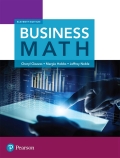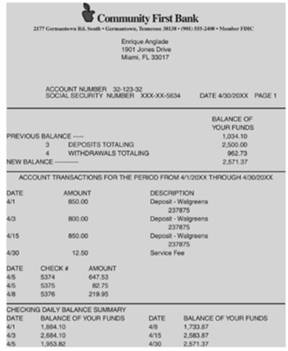
EBK BUSINESS MATH
11th Edition
ISBN: 8220103632072
Author: NOBLE
Publisher: Pearson Education (US)
expand_more
expand_more
format_list_bulleted
Concept explainers
Question
Chapter 4, Problem 18ES
To determine
The amount of service charge paid for the month of April for Enrique Anglade, given the transaction details on the check register,

Expert Solution & Answer
Want to see the full answer?
Check out a sample textbook solution
Students have asked these similar questions
Please answer this correctly with complete solution please
Please answer this correctly and show me the complete solution
Who is the better student, relative to his or her classmates? Here’s all the information you ever wanted to know
Chapter 4 Solutions
EBK BUSINESS MATH
Ch. 4.1 - Prob. 1-1SCCh. 4.1 - Prob. 1-2SCCh. 4.1 - Prob. 1-3SCCh. 4.1 - Prob. 1-4SCCh. 4.1 - Prob. 1-5SCCh. 4.1 - Prob. 2-1SCCh. 4.1 - Prob. 2-2SCCh. 4.1 - Prob. 2-3SCCh. 4.1 - Prob. 2-4SCCh. 4.1 - Prob. 1SE
Ch. 4.1 - Prob. 2SECh. 4.1 - Prob. 3SECh. 4.1 - Prob. 4SECh. 4.1 - Prob. 5SECh. 4.1 - Prob. 6SECh. 4.1 - Prob. 7SECh. 4.1 - Prob. 8SECh. 4.1 - Prob. 9SECh. 4.1 - Prob. 10SECh. 4.1 - Prob. 11SECh. 4.1 - Prob. 12SECh. 4.2 - Prob. 1-1SCCh. 4.2 - Prob. 1-2SCCh. 4.2 - Prob. 1-3SCCh. 4.2 - Prob. 1-4SCCh. 4.2 - Prob. 1-5SCCh. 4.2 - Prob. 1-6SCCh. 4.2 - Prob. 1-7SCCh. 4.2 - Prob. 1-8SCCh. 4.2 - Prob. 1-10SCCh. 4.2 - Prob. 1SECh. 4.2 - Prob. 2SECh. 4.2 - Prob. 3SECh. 4.2 - Prob. 4SECh. 4.2 - Prob. 5SECh. 4 - Prob. 1ESCh. 4 - Prob. 2ESCh. 4 - Prob. 3ESCh. 4 - Prob. 4ESCh. 4 - Prob. 5ESCh. 4 - Prob. 6ESCh. 4 - Prob. 7ESCh. 4 - Prob. 8ESCh. 4 - Prob. 9ESCh. 4 - Prob. 10ESCh. 4 - Prob. 11ESCh. 4 - Prob. 12ESCh. 4 - Prob. 13ESCh. 4 - Prob. 14ESCh. 4 - Prob. 15ESCh. 4 - Prob. 16ESCh. 4 - Prob. 17ESCh. 4 - Prob. 18ESCh. 4 - Prob. 19ESCh. 4 - Prob. 20ESCh. 4 - Prob. 21ESCh. 4 - Prob. 22ESCh. 4 - Prob. 23ESCh. 4 - Prob. 24ESCh. 4 - Prob. 25ESCh. 4 - Prob. 26ESCh. 4 - Prob. 27ESCh. 4 - Prob. 28ESCh. 4 - Prob. 29ESCh. 4 - Prob. 30ESCh. 4 - Prob. 1PTCh. 4 - Prob. 2PTCh. 4 - Prob. 3PTCh. 4 - Prob. 4PTCh. 4 - Prob. 5PTCh. 4 - Prob. 6PTCh. 4 - Prob. 7PTCh. 4 - Prob. 8PTCh. 4 - Prob. 9PTCh. 4 - Prob. 10PTCh. 4 - Prob. 11PTCh. 4 - Prob. 1CTCh. 4 - Prob. 2CTCh. 4 - Prob. 3CTCh. 4 - Prob. 4CTCh. 4 - Prob. 5CTCh. 4 - Prob. 6CTCh. 4 - Prob. 7CTCh. 4 - Prob. 8CTCh. 4 - Prob. 9CTCh. 4 - Prob. 10CTCh. 4 - Prob. 1CPCh. 4 - Prob. 2CPCh. 4 - Prob. 1CS1Ch. 4 - Prob. 2CS1Ch. 4 - Prob. 3CS1Ch. 4 - Prob. 4CS1Ch. 4 - Prob. 1CS2Ch. 4 - Prob. 2CS2Ch. 4 - Prob. 3CS2Ch. 4 - Prob. 4CS2
Knowledge Booster
Learn more about
Need a deep-dive on the concept behind this application? Look no further. Learn more about this topic, subject and related others by exploring similar questions and additional content below.Similar questions
- Pls help asaparrow_forward3. A bag of Skittles contains five colors: red, orange, green, yellow, and purple. The probabilities of choosing each color are shown in the chart below. What is the probability of choosing first a red, then a purple, and then a green Skittle, replacing the candies in between picks? Color Probability Red 0.2299 Green 0.1908 Orange 0.2168 Yellow 0.1889 Purple 0.1736arrow_forwardPls help asaparrow_forward
arrow_back_ios
SEE MORE QUESTIONS
arrow_forward_ios
Recommended textbooks for you
 Discrete Mathematics and Its Applications ( 8th I...MathISBN:9781259676512Author:Kenneth H RosenPublisher:McGraw-Hill Education
Discrete Mathematics and Its Applications ( 8th I...MathISBN:9781259676512Author:Kenneth H RosenPublisher:McGraw-Hill Education Mathematics for Elementary Teachers with Activiti...MathISBN:9780134392790Author:Beckmann, SybillaPublisher:PEARSON
Mathematics for Elementary Teachers with Activiti...MathISBN:9780134392790Author:Beckmann, SybillaPublisher:PEARSON
 Thinking Mathematically (7th Edition)MathISBN:9780134683713Author:Robert F. BlitzerPublisher:PEARSON
Thinking Mathematically (7th Edition)MathISBN:9780134683713Author:Robert F. BlitzerPublisher:PEARSON Discrete Mathematics With ApplicationsMathISBN:9781337694193Author:EPP, Susanna S.Publisher:Cengage Learning,
Discrete Mathematics With ApplicationsMathISBN:9781337694193Author:EPP, Susanna S.Publisher:Cengage Learning, Pathways To Math Literacy (looseleaf)MathISBN:9781259985607Author:David Sobecki Professor, Brian A. MercerPublisher:McGraw-Hill Education
Pathways To Math Literacy (looseleaf)MathISBN:9781259985607Author:David Sobecki Professor, Brian A. MercerPublisher:McGraw-Hill Education

Discrete Mathematics and Its Applications ( 8th I...
Math
ISBN:9781259676512
Author:Kenneth H Rosen
Publisher:McGraw-Hill Education

Mathematics for Elementary Teachers with Activiti...
Math
ISBN:9780134392790
Author:Beckmann, Sybilla
Publisher:PEARSON


Thinking Mathematically (7th Edition)
Math
ISBN:9780134683713
Author:Robert F. Blitzer
Publisher:PEARSON

Discrete Mathematics With Applications
Math
ISBN:9781337694193
Author:EPP, Susanna S.
Publisher:Cengage Learning,

Pathways To Math Literacy (looseleaf)
Math
ISBN:9781259985607
Author:David Sobecki Professor, Brian A. Mercer
Publisher:McGraw-Hill Education
Use of ALGEBRA in REAL LIFE; Author: Fast and Easy Maths !;https://www.youtube.com/watch?v=9_PbWFpvkDc;License: Standard YouTube License, CC-BY
Compound Interest Formula Explained, Investment, Monthly & Continuously, Word Problems, Algebra; Author: The Organic Chemistry Tutor;https://www.youtube.com/watch?v=P182Abv3fOk;License: Standard YouTube License, CC-BY
Applications of Algebra (Digit, Age, Work, Clock, Mixture and Rate Problems); Author: EngineerProf PH;https://www.youtube.com/watch?v=Y8aJ_wYCS2g;License: Standard YouTube License, CC-BY